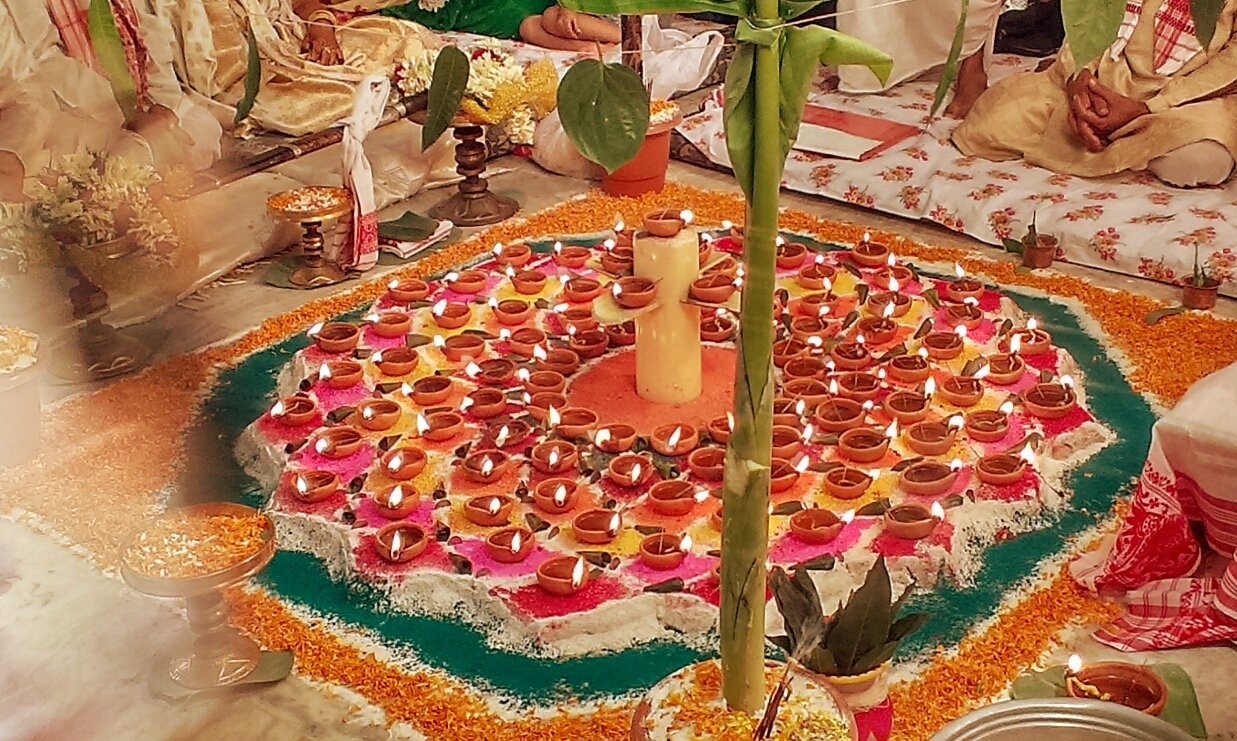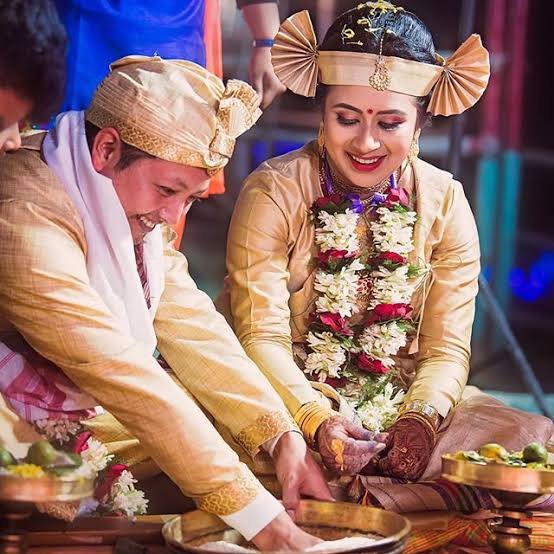Marriages are made in heaven but solemnized on Earth
This is a popular saying on the institution of marriage and sounds cliche. But trust me, the customs, ceremonies, and rituals involved in a marriage are so varied, yet grand and beautiful that the institution itself cannot be cliche. An Assamese marriage ceremony is different for every ethnic community in Assam and each has its own intricate ritualistic affair.
Choklong is the unique marriage ceremony of the Tai-Ahom community of Assam. Choklong is the marriage ceremony performed in the divine presence of the Gods by lighting 101 earthen lamps.

In the ancient days, the Choklong marriage ceremony was a nine-day long ritualistic affair. But nowadays it has been reduced to three days namely Juron diya, Murot tel diya, and the main day Choklong ceremony. The Ahom priestly classes, i.e., Deodhai, Mohan and Bailung perform all the religious ceremonies of the community which included the marriage ceremonies as well. They had full knowledge of the Choklong system of marriage and therefore full authority too.
The most important aspect of a Choklong marriage is the lighting of the 101 earthen lamps. On the day of the marriage an altar is prepared which is called the Maral. It is basically an extensive rangoli decorated with 101 earthen lamps. In the rangoli pattern, 16 small earthen lamps are arranged in 6 concentric circles, and 4 medium earthen lamps are placed in the innermost circle. In the centre a large earthen lamp is placed. Another important part of the Choklong marriage is the Hengdang which is a single-edged sword with a long handle. The Hengdang is offered by the bride to the bridegroom which has a lot of symbolism. By accepting the Hengdang the groom is basically promising to protect his bride lifelong and look after the family. In the ancient days, the groom accepting the Hengdang meant that he would defend his country against enemies and thereby protect the nation.

Source – ancientpages.com
The Wedding Dress
The wedding apparel of the bride and groom in a Choklong marriage is so royal and elegant that it adds to the grandeur of the ceremony. The groom wears a kurta and dhoti with a turban on his head. A traditional cheleng sador is wrapped around the groom’s kurta. All these are made of our very own Muga silk, sometimes paat silk also. The bride wears a mekhela, reeha, full sleeved shirt like blouse, and a muga headgear. With time, however, the traditional mekhela sador is widely worn by the bride with the headgear.
Learn more about Assamese wedding dress in The Silk Tales – Assam Traditional Silk.
Every girl, at some point in her life, fantasises about her marriage even if for a second. She wants to look the best on her wedding day and fantasises her wedding dress, the jewelry, the sets, customs and rituals as well. I was no exception to this. In fact, from the day I learned about the royal Ahom Choklong marriage ceremony, I was very sure I am going to have one. My favorite part of the ceremony was the offering of the Hengdang to the groom by the bride. For me, it seemed larger than life event with the groom dressed in traditional Muga kurta and dhoti along with a muga turban. I was mesmerised by the thought of the groom promising to protect the bride from all evil with the Hengdang in his hands.

Source: https://instagram.com/frozenframeproduction?igshid=sj5401s2q2on
The Wedding Rituals
An Assamese marriage these days is traditional with its unique customs and rituals, but also with a touch of modernity as far as the attire, extensive sets and glamour are concerned. It is an amalgamation of both. Ceremonies and rituals start many days ahead of the actual wedding day. In my previous post on Xajpani I had mentioned about Na purushor hokaam. This is the first ritual in any Assamese marriage which takes a few days prior to the marriage. The name, however, may vary with different communities.
The ceremony starts with the Juron diya. The family of the groom brings gifts for the bride which includes her wedding trousseau, along with gold and traditional Assamese jewelry, cosmetics, ceremonial maah halodhi to be applied by the bride on her wedding day. There are many other things brought along with these. These are brought in two earthen pots, one with gifts for the bride,another with maah halodhi. The bride takes out a portion of the maah halodhi and leaves some for the groom in the same pot which is later carried back to the groom. Juron is given by the groom’s mother and other female relatives and basically is an all-female ceremony. The bride later changes her attire to the ones gifted by the groom’s family and seeks blessings from the elderly people present in the ceremony.
There’s another ritual called koina or dora nuuwa meaning bathing the bride and groom in a ceremonial way. This is arranged in the respective places of the bride and groom. The maah halodhi kept aside during the Juron ceremony is applied on the body of the bride and groom, and later washed with water. For this a bei is made with bamboo where the bride and groom are made to sit for the ritual. Under this bei is buried one egg, a needle, kasi, betel nut and a coin. This ritual signifies cleansing the bride and groom of any impurities or evil spirits thereby preparing them for their new life. The water used during this ritual is brought from a nearby river or lake in another ritualistic manner. The mother along with the ladies of the family and community goes to a nearby water body singing biya naam. This ritual is called pani tola.
Murot tel diya is solemnized on the next day after juron. Biya naam are traditional wedding songs sung during this ritual, and in fact throughout all the ceremonies related to marriage. The bride is applied tel now by her relatives and other female guests. The female guests gathered then asks for xoraai from all the family and relatives by singing biya naam. The xoraai basically consists of tamul-paan, gamucha, money, sweets etc. given to the ladies which is an expression of happiness and thanksgiving. This is more like a fun ceremony.
An Assamese Choklong marriage is an elaborate affair, a larger than life affair as all other Assamese marriages are. One cannot but be awe- inspired to witness such a marriage. It is all about customs and rituals. But with modernisation there has been some positive changes too which, however, have not affected the rituals. Videographers, photographers, make-up artists, dress designers, jewellery designers are involved nowadays to make a marriage more memorable. In Assam we have a talented bunch of such artists who gave given a whole new look to our traditional marriage ceremonies and taken it to another level. So if you ever get an invite to attend a Choklong marriage or any other Assamese marriage, do not miss the opportunity. You would be more than happy to be a part of an Assamese marriage.
Also I am very excited to inform that my first non-fiction travel guide book on Assam Jajabor: Wanderlust Assam has been published with an ISBN number. I am sure the book would be helpful and interesting, covering a lot of different topics on Assam as a tourist destination. If you wish to purchase a copy then I will be adding the link below.
Book link: https://notionpress.com/read/jajabor-wanderlust-assam

2 comments